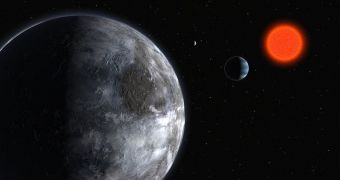According to the conclusions of a new scientific study, it would appear that a super-Earth located in the Gliese 581 star system is incapable of spreading life on the other worlds. Simulations indicate that material exchange between the worlds in this system is scarce, and unfavorable to spreading life.
The extrasolar planet Gliese 581d is the first terrestrial-mass world to be classified as habitable. It received this designation in May 2011, after a team of French investigators released a 3D model of its climate. The data showed a stable atmosphere.
The world is located at the boundary of its parent star's habitable zone, which means that liquid water may exist on its surface. It is the fifth planet in order from the red dwarf parent star, and has a mass about 5.6 times that of Earth.
Astronomers say that this planetary system is located about 20 light-years away, in the constellation of Libra. As soon as the French team released its results, they began considering the possibility that life may have developed on this world.
During the new investigation, they concluded that the super-Earth may have very well developed at least some forms of life, but said that it's unlikely these organisms were transferred to other planets.
In our own solar system, astronomers found evidence of exchanges that took place between Mars and Earth, for example. A large cosmic impact can throw debris in orbit and beyond, which then spend millions of years orbiting the Sun, before finally crashing on another world.
“One of the big scientific questions is how did life get started and how did it spread through the Universe,” Purdue University distinguished professor of earth and atmospheric sciences, Jay Melosh, explains. He led the work with physics and planetary science student, Laci Brock.
“That question used to be limited to just the Earth, but we now know in our solar system there is a lot of exchange that takes place, and it's quite possible life started on Mars and came to Earth. There's also been a great deal of discussion about the possible spread of life in the universe from star to star,” Melosh explains.
The team presented details of its findings on March 20, at the 43rd Lunar and Planetary Science Conference, which is held in The Woodlands, Texas.
“Laci has found the somewhat surprising result that it is very difficult for materials to spread throughout that system in the same way it could take place in our solar system,” Melosh concludes.

 14 DAY TRIAL //
14 DAY TRIAL //